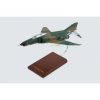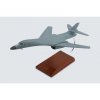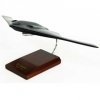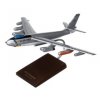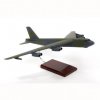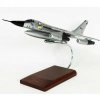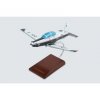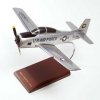"The supersonic long-range all-weather F-4 Phantom II was designed for the United States Navy (USN) by McDonnell Douglas. It first entered service in 1960. During the Vietnam War, it was the primary air superiority fighter and a workhorse fighter-bomber for the US Air Force (USAF), Navy and Marine Corps. By 1963, it had been adopted by the USAF for the fighter-bomber role. When production ended in 1981, a total of 5,195 F-4s had been built, making it the most numerous American supersonic military aircraft. In 2000, over 1,000 units were in service with 11 nations worldwide. Innovations in the F-4 included an advanced pulse-doppler radar and extensive use of titanium in the airframe. It could carry up to 8,480 kg of weapons such as air-to-air and air-to-ground missiles, as well as unguided, guided and nuclear bombs. The F-4E is the leading Phantom model, with 1,389 planes built. It took its maiden flight on June 30, 1967. The F-4E had an additional fuselage fuel tank, leading-edge slats for increased maneuverability, an improved engine, and an internally mounted 20 mm multibarrel gun with an improved fire-control system. The slats, weapons and radar controls were optimized for dogfighting, thus improving the aircraft's air-to-air capabilities. In air combat, the F-4's greatest advantage was its thrust, which permitted a skilled pilot to engage and disengage from the fight at will. Due to its distinctive appearance and its widespread service with various militaries, the F-4 is one of the best known icons of the Cold War. It performed well in the Vietnam War and Arab-Israeli conflicts, with F-4 crews achieving 393 aerial victories and completing countless ground attack sorties. The Phantom II has the distinction of being the last US fighter to attain ace status in the 20th century. It has also set 16 world records, and was the only aircraft used by both the USAF Thunderbirds and the USN Blue Angels. "
Scale: 1/48 scale model
Wing Span: 10
Length: 16.5
CF004ACT
|
"The long range, multi-role B-1 Lancer began as a replacement for the B-52 Stratofortress in the 1960s. It carries the largest payload of both guided and unguided weapons in the United States Air Force (USAF) inventory. The supersonic strategic bomber can rapidly deliver large quantities of precision and non-prescision weapons against any adversary to any location at any time. Although officially nicknamed the “Lancer”, B-1 crews prefer to call it the “Bone”. The origins of this nickname seem to have come from an early newspaper article about the aircraft, wherein its name was phonetically spelled out as “B-ONE”. The B-1B production version first flew in October 1984 and has been in service with the USAF since 1986. It is an improved variant initiated in 1981 by the Reagan administration. Major changes included additional structure to increase payload by 74,000 pounds, an improved radar and a radar cross section reduction. The B-1B's blended wing/body configuration, variable-geometry wings and turbofan afterburning engines all contribute to its long range, maneuverability, high speed and survivability. Its offensive avionics system allows tracking, targeting and engaging moving vehicles as well as self-targeting and terrain-following modes. The final B-1B was delivered on May 2, 1988. The B-1B was first used in combat during Operation Desert Fox in Iraq in December 1998. In 1999, six aircraft were used in Operation Allied Force, delivering more than 20 percent of the total ordnance while flying less than 2 percent of the combat sorties. B-1Bs were also deployed in support of Operation Enduring Freedom, dropping almost 40 percent of the total tonnage during the first six months. All of this was accomplished while maintaining an impressive 79 percent mission capable rate. "
Scale: 1/100 scale model
Wing Span: 16
Length: 17.5
CB1TR
|
"The B-2 Spirit aircraft began as a black project identified as High Altitude Penetrating Bomber. Then it became the Advanced Technology Bomber, utilizing the code Senior Cejay. Afterwards, it became the B-2 Spirit. In 1980’s, 23 billion dollars were spent secretly for studies and advancement of the aircraft. In 1985, the aircraft became a low altitude bomber from a high altitude bomber, which they spent an extra cost for. The B-2 was in service in three operations. Its first appearance was in the Kosovo War in 1999. It first brought the satellite guided JDAM in operations. Because of that, it was used in Operation Enduring Freedom in Afghanistan and in Operation Iraqi Freedom. The B-2 is extremely computerized. And unlike those single seat fighter aircrafts, a crew can sleep inside a B-2, set his meals or use a toilet. The B-2 Spirit is a stealth heavy bomber and has the ability of organizing both nuclear and conventional armaments. It is privately operated by the United States Air Force. Its advancement was a highlight in the upgrading program of the United States Department of Defense. The B-2 aircrafts 2nd generation stealth technology was to assist the aircraft's penetration function to go on tremendous anti-aircraft protection. "
Scale: 1/100 scale model
Wing Span: 20.5
Length: 8
CB22TR
|
"The Northrop Grumman B-2 Spirit is a multi-role stealth heavy bomber, capable of deploying both conventional and nuclear weapons. It is operated exclusively by the United States Air Force. The B-2 Spirit or stealth bomber was developed and built by an industry team consisting of Northrop Grumman, Boeing and Vought Aircraft Industries. The B-2 started life as a black project known as the High Altitude Penetrating Bomber (HAPB), then became the Advanced Technology Bomber (ATB), and later became the B-2 Spirit. The B-2s primary mission is to attack time-critical targets early in a conflict to minimize an enemy's war-making potential. The B-2 bomber aircraft features incorporates advanced designs and technologies that make unprecedented use of composite materials, product assembly and finishing that meet extraordinary tolerances and quality standards and it doesn't use development tooling since it incorporates final production tooling implemented directly from the computer-aided design (CAD) system. The first B-2 was publicly displayed on November 22, 1988, when it was rolled out of its hangar at Air Force Plant 42, Palmdale, California, where it was built. Its first public flight was on July 17, 1989. In 1991, the USAF and B-2 industry team received the Collier Trophy. It will be unlikely that any B-2 will be placed on permanent display in the future (or anytime before airtime retirement)."
|
The first B-47E flew on 30 January 1953. Four "blocks" or "phases" of the B-47E were built, each incorporating refinements on the previous block, and also sometimes featuring production changes within a block. Older blocks were generally brought up to the specifications of later blocks as they were introduced. Early production "B-47E-Is" also known featured J47-GE-25 turbojets with 27 kN (5,970 lbf) thrust, but they were quickly changed to J47-GE-25A engines, which featured a significant improvement in the form of water-methanol injection. This was a scheme in which a water-methanol mix was dumped into the engines at takeoff, increasing mass flow and so temporarily kicking the thrust up to 32 kN (7,200 lbf). Methanol was apparently added to the water as an anti-freezing agent. The engines left a trail of black smoke behind them when water-methanol injection was on.
Scale: 1/100 scale model
Wing Span: 14.38
Length: 13
CB47T
|
"The B-52 Stratofortress is a long-range, jet strategic bomber that replaced the Convair B-36 and the Boeing B-47. Built by Boeing Aircraft CB-52G Stratofortressorporation in Wichita, Kansas, it has been operated by the United States Air Force (USAF) since 1955. Rarely called by its official name Stratofortress, it is more commonly referred to as BUFF (Big Ugly Fat Fellow). On November 23, 1945, Air Materiel Command, a former USAF command, issued desired performance characteristics for a new strategic bomber. Boeing, Consolidated Aircraft and Glenn L. Martin Company all submitted proposals, with Boeing winning the design competition. The primary nuclear-roled bomber in the USAF inventory, the B-52 was designed to reduce the overall aircraft weight in an effort to improve performance and has the longest unrefueled range of any bomber. It can carry up to 60,000 pounds of nuclear or conventional ordnance and can fly at high subsonic speeds and altitudes with worldwide precision navigation capability. The first B-52G aircraft rolled out of the production plant in the summer of 1958. The “G” model was heavier than earlier variants and had increased unrefueled range. Other changes included an enlarged nose radome, a reduced vertical fin size, a modified tail cone and removed ailerons. "
Scale: 1/100 scale model
Wing Span: 22.25
Length: 19
CB52GT
|
"The Convair B-58 Hustler was the first operational jet bomber capable of Mach 2 supersonic flight and was developed for the United States Air Force Strategic Air Command in the late 1950s. The B-58 program started in February 1949. The B-58 design was the first ""true"" USAF supersonic bomber program. Its design was based on a delta wing with a leading-edge sweep of 60 degrees with four General Electric J79-GE-1 turbojet loading. It has a crew of three, the pilot, bombardier, navigator and defensive systems operator. The B-58 carries a single nuclear weapon in a streamlined MB-1C pod under the fuselage. The B-58 has a crew of three and has a maximum speed of Mach 2.1 The B-58 is extremely expensive and was reported that each B-58As costs much more than its weight in gold. It is a complex aircraft requiring considerable maintenance, requiring specialized equipment. On January 16, 1970, the last B-58s in operational service retired and was replaced by the FB-111A. A total of 116 B-58s were produced; 30 trial aircraft and 86 production B-58A models. A number of B-58s were used for special trials of various kinds and several variants such as the B-58B and B-58C were proposed by Convair, but were never built. "
|
"The C-5 Galaxy is a strategic airlifter type of aircraft manufactured by Lockheed-Georgia Co. Its maiden flight was on the 30th of June 1968 and was introduced commercially in 1970. Its primary user was the United States Air Force and it is still operational up to this date with 52 produced aircrafts active and 42 reserved. It is one of the largest aircrafts in the world and the largest American military transport. It was designed to carry oversized cargo. The C-5A was produced during 1968 to 1973. It was the original version of the C-5 Galaxy. In 1970s a crack on its wings was found that caused its cargo weight restriction. The C-5A was redesigned to install new strengthened wings. The new set of wings is made of an aluminum alloy that didn’t exist during its first production. The C-5B was produced on 1985 to 1989.It was an improved version of the original variant of C-5 Galaxy. It allows four minimum flight crews including the Pilot, co-pilot, and two flight engineers. It has a payload of 270,000 lb; length of 247 feet 1 inches; wingspan of 222 feet 9 inches; height of 65 feet 1 inches. It has a maximum speed of Mach 0.79; cruise speed of Mach 0.77; range of 2,400 nmi; and service ceiling of 34,000 feet. Fifty new variants of C-5B were delivered to the United States Air Force from 1986 to 1989. "
Scale: 1/150 scale model
Wing Span: 18
Length: 20
CC005ET
|
"The Lockheed C-5 Galaxy is a military transport aircraft, the largest in the American military and one of the largest in the world. It was designed to carry outsize and oversize cargo, providing strategic heavy airlift over intercontinental distances. Operated by the United States Air Force (USAF), it is one of the physically largest aircraft in the world that is capable of flying on a regular basis. In 1964, design proposals for a heavy jet transport were submitted by various companies in response to a US Army requirement. The new aircraft was set to replace the Douglas C-133 Cargomaster and complement the Lockheed C-141 Starlifter. In 1965, Lockheed's aircraft design and General Electric's engine design were selected. The first C-5A Galaxy rolled out of the manufacturing plant on March 2, 1968 and the aircraft's maiden flight was on June 30. The first operational Galaxy was delivered in June 1970. The C-5 has a distinctive high T-tail and is similar in appearance to its smaller sister transport the C-141. It is equipped for aerial refueling, giving it an extended range. Nose and aft doors permit “drive-through” loading and unloading of cargo. The Galaxy is capable of carrying nearly all of the Army's combat equipment, including the 74-ton armored vehicle launched bridge, from the United States to any location in the world. In the early 1970s, the C-5 was considered by NASA for the role of Shuttle Carrier Aircraft, which was tasked to transport the Space Shuttle to Kennedy Space Center. However, the Boeing 747 was chosen instead due in part to its low-wing design. From 1981 to 1987, 77 C-5As underwent a re-winging program to increase their lifting capability and service life after wing cracks were found throughout the fleet. The redesigned wings were made of a new aluminum alloy that did not exist during the original production. "
Scale: 1/150 scale model
Wing Span: 18
Length: 20
CC005GT
Pre-Order! Available: June
|
"The C-5 Galaxy, manufactured by Lockheed-Georgia Co., is a military heavy-cargo transport aircraft designed to provide strategic airlift for deployment and supply of combat and support forces over intercontinental distances. It is the largest American military transport and one of the largest military aircraft in the world, designed to carry outsize and oversize cargo. The C-5 is operated by the United States Air Force. The C-5 Galaxy is one of the physically largest aircraft in the world with the ability to fly on a regular basis. The original version of the C-5 is the C-5A. From 1969 to 1973, 81 C-5As were delivered to US Air Forces bases. Due to cracks found in the wings in the mid-1970s, the cargo weight was restricted. To restore the plane's full capability, the wing structure was redesigned. A program to install new strengthened wings on 77 C-5As was conducted from 1981 to 1987. The redesigned wing made use of a new aluminum alloy that didn't exist during the original production. An improved version of the C-5A is the C-5B. It incorporated all modifications and improvements made to the C-5A with improved wings, upgraded TF-39-GE-1C turbofan engines and updated avionics. From 1986 to 1989, 50 of the new variant were delivered to the US Air Force. "
Scale: 1/150 scale model
Wing Span: 18
Length: 20
CC005T
|
Scale: 1/100 scale model
Wing Span: 17.5
Length: 18.5
CE6BT
|
"The T-6 Texan is a single-engine advanced trainer aircraft used to train fighter pilots of the United States Army Air Forces, United States Navy, Royal Air Force and other air forces of the British Commonwealth during World War II. The T-6 is known by a variety of designations depending on the model and operating air force such as the ""AT-6"", the ""SNJ"" and ""Harvard"". The T-6 originates from the North American NA-16 prototype which was first sloen on April 1, 1935. The T-6 originated from the American NA-16 prototype which was modified as the NA-26 and entered USAC ""Basic Combat"" aircraft competition in March 1937. Production of the first model began and there were 180 supplied to the USAAC as the BC-1 and 400 to the RAF as the Harvard I. The US Navy received 16 modified aircraft, designated as the SNJ-1, and the 61 as the SNJ-2 with a different engine. The AT-6, which was equivalent to the BC-1A was designated as the Harvard II for RAF/RCAF orders and 1,173 were supplied by purchase or Lend Lease, mostly operating in Canada. Next comes the AT-6A, based on the NA-77 design powered by Pratt & Whitney R-1340-49 Wasp radial engine. The USAAF received 1,549 and the US Navy 270 (as the SNJ-3). It has a maximum speed of 208 mph at 5,000 ft and a range of 730 miles. The Texans were put into service during the Korean War and the Vietnam War. Texans had also been a regular participant in air shows and was used in many movies. "
Scale: 1/32 scale model
Wing Span: 10.75
Length: 15.75
AT06NYT
|
"Built by Raytheon, the T-6A Texan II is a turboprop aircraft of World War II used by the U.S. Air Force and U. S. Navy for their basic pilot training. Since World War II, the Texan has been a popular war bird and is a regular participant at air shows. The T-6A Texan II was manufactured by Raytheon Aircraft Company and Hawker Beechcraft. It is a single-engine with two seats designed to be a trainer aircraft. Its primary users are United States Air Force and Navy; Canadian Forces, and Greek Air Force. It entered development flight in July 1998, production line on the 30th of July 1999, and flight test program and full rate production decision in December 2001. The T-6A was primarily designed to train JPPT or Joint Primary Pilot Training students in basic flying skills common in the United States Air Force and Navy pilots. It was a military trainer version of the Beech/Pilatus PC-9 Mk II by Raytheon. The single cockpit with two seats placed one crewmember in front of the other. The students and the instructor’s positions can be interchangeable. Pilots can enter the T-6A cockpit through a side opening. The T-6A has a Pratt and Whitney Canada PT6A-68 turbo-prop that delivers 1,100 horsepower. It is fully aerobatic aircraft with a pressurized cockpit and an anti-G system. It also has an ejection seat and advanced avionics package with sunlight-readable liquid crystal displays. Since World War II the Texan has been known as a war bird and a regular participant in air shows"
Scale: 1/32 scale model
Wing Span: 12.38
Length: 12
AT06NYTR
|
"When the United States Air Force (USAF) set out to replace the aging T-6 Texan trainer, North American Aviation (NAA) was hired to do the job. The design presented by NAA was so successful that a contract for two prototypes was awarded. The USAF was impressed with the prototypes after an evaluation and an initial flight on September 24, 1949. The new aircraft, designated the T-28 Trojan, entered prodution the following year, becoming the first all-new post World War II trainer. It had a frameless canopy and piston engine, with a top speed that often exceeded 280 mph. It was the first trainer designed to transition pilots to jet aircraft. However, plans to utilize it for both basic and advanced training had to be changed when it turned out that the speed and power of the Trojan challenged new cadets too soon. After it became evident that the Air Force had found a very successful design, the US Navy and the US Marine Corps adopted the T-28 military trainer aircraft as well. It was used by the US armed forces from the 1950s to the 1980s. The Air Force has supplied T-28 planes to the Vietnam Air Force, the Royal Laotian Air Force and the Royal Thai Air Force. The Trojan served with the USAF as a tactical fighter-bomber for counter insurgency warfare in Southeast Asia, particularly in Vietnam and Laos, and proved to be an effective close air support weapon against enemy ground forces. The T-28 was the first US attack fixed wing aircraft that was lost in South Vietnam during the Vietnam War. Captain Robert L. Simpson and Lieutenant Hoa were shot down by ground fire on August 28, 1962 while flying close air support; neither survived. The USAF lost 23 Trojans to all causes during the war, with the last two losses occurring in 1968. "
Scale: 1/32 scale model
Wing Span: 15
Length: 12.25
AT28AT
|
"The T-28 Trojan was the basic trainer for both the Navy and Air Force. Like the T-6 Texan that it replaced in the early 50s, many were converted to ground attack variants and saw action in Vietnam. The T-28 Trojan, manufactured by North American Aviation (NAA), was designed as a piston-engined military trainer aircraft. The T-28 was flown for the first time, designed to replace the T-6 Texan, on September 24 1949. The first of two prototypes was flown on September 26, 1949. Found satisfactory, a contract was issued and between 1950 and 1957. There were a total of 1,948 aircrafts built. A number of these aircraft were later supplied to Air Forces in South America and South East Asia particularly in Japan, Argentina, Thailand, Laos, Philippines, and Brazil. The Trojan, as it became known, had a frameless canopy and a Wright R-1300 engine that, when combined, and gave it a top speed that often exceeded 280 mph. First orders of 266 planes in 1950 eventually grew to 1,194. After it became evident that the Air Force had found a very successful design, the United Sates Navy and Marine Corps adopted it as well. Two years later, 489 standardized versions (T-28Bs) were ordered by the Navy, mainly differing from the T-28A in its use of the more-powerful Wright R-1820-86 engine. Following this, 299 T-28Cs were produced, which were fitted with an arrester gear for carrier-deck landing training. "
Scale: 1/32 scale model
Wing Span: 15
Length: 12.25
AT28NT
|

